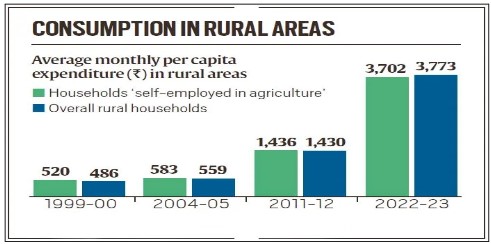GS3-Economy
Introduction
The Household Consumption Expenditure Survey (HCES) is conducted every five years by the National Statistical Office (NSO) and serves as a crucial tool for gathering information about the spending habits of households.
This survey is designed to collect data on the :
- consumption of goods and services, and
- offering insights into the economic behavior of households.
The Household Consumption Expenditure Survey (HCES) is important to understand:
- The ways households usually spend money on goods (including food and non-food items) and services.
- In figuring out estimates for the household Monthly Per Capita Consumer Expenditure (MPCE).
- The spending of individuals in a household on average.
- Analyzing how households and individuals are spread out across different MPCE categories,
- The insights into spending patterns and economic distribution.
The information gathered through HCES is valuable for understanding household consumption patterns and plays a vital role in deriving macroeconomic indicators such as Gross Domestic Product (GDP), poverty rates, and Consumer Price Inflation (CPI). However, it's worth mentioning that the findings of the previous HCES conducted in 2017-18 were not released by the government, citing concerns related to "data quality" issues. This highlights the importance of ensuring accuracy and reliability in the collected data to maintain the credibility of surveys and their subsequent implications for economic indicators and policy decisions.
Highlights of the report:
- A significant reduction in the country's poverty rate, down to 5%.
- A significant increase in the average monthly per capita consumption expenditure (MPCE) in urban households by 33.5% since 2011-12, reaching ₹3,510, and rural India's MPCE increased by 40.42% to ₹2,008.
- In 2022-23, 46% of rural household spending and 39% of urban household spending were on food items.
- The distribution of MPCE by population percentiles reveals that the bottom 5% of India’s rural population has an average MPCE of ₹1,373, while the top 5% has ₹10,501.
- In urban areas, it's ₹2,001 for the bottom 5% and ₹20,824 for the top 5%.
- State-wise variations in MPCE:
- Highest MPCE- Sikkim with ₹7,731in rural areas, and ₹12,105 in urban areas.
- Lowest MPCE- Chhattisgarh with ₹2,466 for rural households and ₹4,483 for urban households.
- Rural-urban differences in MPCE are highest in Meghalaya (83%) and Chhattisgarh (82%).

- Among Union Territories:
- Highest MPCE- Chandigarh with Rs. 7,467 in rural and Rs. 12,575 in Urban.
- Lowest MPCE- Rural Ladakh with Rs. 4,035 and Urban Lakshadweep with Rs. 5,475
- Food spending trends:
- It indicates a decline in the share of expenditure on food since 1999-2000, with an increase in spending on non-food items for both urban and rural households.
- A decrease in the share of cereals and pulses in overall food consumption expenditure, and spending on conveyance is the highest among non-food items.
- Till 2022-23, fuel and light used to see the highest consumption spending among non-food items.
Note: The recent survey on spending habits highlights does not include free items from social welfare programs like Pradhan Mantri Garib Kalyan Yojana in the calculations.
What is the National Statistical Office (NSO)?
- Established in 2019 by merging the Central Statistical Office (CSO) and the National Sample Survey Office (NSSO).
- The idea for NSO was first proposed by the C. Rangarajan Committee, which envisioned it as the central authority for all core statistical activities.
- It currently operates under the Ministry of Statistics and Programme Implementation (MoSPI).
- Function: To collect, compile, and disseminate reliable, objective, and relevant statistical data.
- Aim: To streamline and enhance the efficiency of statistical activities in the country by consolidating the functions of CSO and NSSO.
Challenges associated
- Inclusivity in Surveys: The data from surveys, such as the Household Consumption Expenditure Survey, might not fully represent the diverse population, particularly marginalized or hard-to-reach communities. Ensuring inclusivity in survey samples poses a challenge for NSO to generate representative and comprehensive data.
- Interpreting Poverty Reduction: While the recent survey indicates a decrease in poverty rates to 5%, challenges may arise in interpreting these numbers accurately. The definition of poverty, the methodologies used, and the exclusion of certain factors can impact the reliability of poverty reduction figures.
- Timely Release of Data: The delay in releasing survey findings, as seen in the case of HCES 2017-18, raises concerns about the timeliness of data dissemination. Ensuring that statistical information is released promptly is crucial for policymakers, researchers, and the public to make informed decisions.
- Standardization of Measurement: The variations in Monthly Per Capita Consumer Expenditure (MPCE) across states and union territories highlight the need for standardization in measurement. Ensuring consistency in survey methodologies and metrics is a challenge to provide a more accurate and comparable analysis.
- Communication of Findings: Presenting survey findings in a way that is easily understandable to the public is essential. The challenge lies in effectively communicating complex statistical data to diverse audiences, ensuring transparency, and promoting public awareness and trust in the statistical processes.
- Adapting to Changing Consumption Patterns: Understanding shifts in spending habits, such as the decline in the share of expenditure on food, poses a challenge for NSO. Adapting methodologies to capture evolving consumption patterns and economic behaviors is crucial for maintaining the relevance of statistical data.
Way forward:
- Enhance Data Quality Assurance:
- Implement rigorous quality assurance measures to address concerns about data quality.
- Invest in advanced data collection techniques, technology, and training for personnel to ensure accurate and reliable information.
- Inclusive Survey Methodologies:
- Develop inclusive survey methodologies that actively consider and incorporate the perspectives of marginalized and hard-to-reach communities.
- Collaborate with community organizations and experts to ensure that surveys are representative of the diverse population.
- Transparency and Stakeholder Engagement:
- Foster transparency in the statistical processes by openly communicating methodologies, data sources, and any potential limitations.
- Engage with stakeholders, including policymakers, researchers, and the public, to gather feedback and insights on data collection methodologies and survey design.
- Timely Data Release:
- Establish streamlined processes to ensure the timely release of survey findings.
- Set clear timelines and benchmarks for data dissemination, enabling prompt access for policymakers, researchers, and the general public.
- Capacity Building and Standardization:
- Invest in continuous training and capacity-building programs for NSO personnel to keep them updated on the latest statistical methodologies and technologies.
- Work towards standardizing measurement metrics and methodologies across states and union territories to enable more accurate and comparable analyses.
Conclusion
The National Statistical Office (NSO) plays a crucial role in generating reliable and relevant statistical data for informed decision-making. While challenges exist, including concerns about data quality and timeliness, there are clear avenues for improvement. Enhancing inclusivity in survey methodologies, ensuring transparency, and investing in capacity building are key steps forward. By addressing these challenges and adopting forward-looking strategies, the NSO can continue to evolve as a vital institution, providing accurate and timely information to support evidence-based policies and initiatives.



